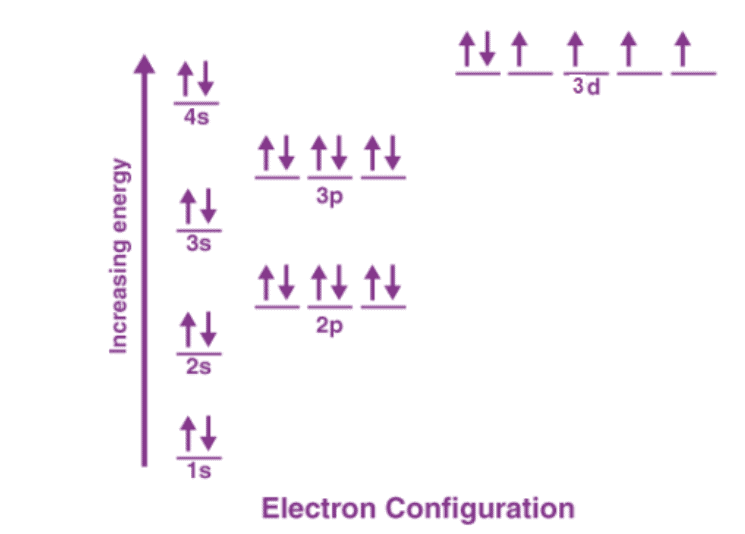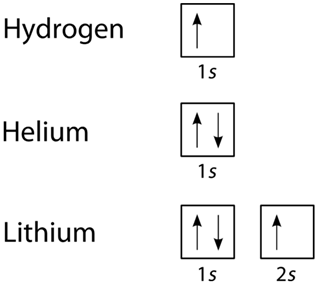Hund's Rule & Pauli's Exclusion Principle | Physical Chemistry PDF Download
Introduction to Hund’s Rule
Aufbau principle tells us that the lowest energy orbitals get filled by electrons first. After the lower energy orbitals are filled, the electrons move on to higher energy orbitals. The problem with this rule is that it does not tell about the three 2p orbitals and the order that they will be filled in.
According to Hund’s rule:
- Before the double occupation of any orbital, every orbital in the sub level is singly occupied.
- For the maximization of total spin, all electrons in a single occupancy orbital have the same spin.
An electron will not pair with another electron in a half-filled orbital as it has the ability to fill all its orbitals with similar energy. Many unpaired electrons are present in atoms which are at the ground state. If two electrons come in contact they would show the same behaviour as two magnets do. The electrons first try to get as far away from each other as possible before they have to pair up.
Hunds Rule of Maximum Multiplicity
Hunds Rule of Maximum Multiplicity rule states that for a given electron configuration, the term with maximum multiplicity falls lowest in energy. According to this rule electron pairing in p, d and f orbitals cannot occur until each orbital of a given subshell contains one electron each or is singly occupied.
State Hund’s Rule
It states that:
- In a sublevel, each orbital is singly occupied before it is doubly occupied.
- The electrons present in singly occupied orbitals possess identical spin.
Explanation of Hund’s Rule
The electrons enter an empty orbital before pairing up. The electrons repel each other as they are negatively charged. The electrons do not share orbitals to reduce repulsion.
When we consider the second rule, the spins of unpaired electrons in singly occupied orbitals are the same. The initial electrons spin in the sub-level decides what the spin of the other electrons would be. For instance, a carbon atom’s electron configuration would be 1s22s22p2. The same orbital will be occupied by the two 2s electrons although different orbitals will be occupied by the two 2p electrons in reference to Hund’s rule.
Electron Configuration and its Purpose

The above image helps in understanding the electronic configuration and its purpose. The valence shells of two atoms that come in contact with each other will interact first. When valence shells are not full then the atom is the least stable. The chemical characteristics of an element are largely dependent on the valence electrons. Similar chemical characteristics can be seen in elements that have similar valence numbers.
The stability can also be predicted by the electron configuration. When all the orbitals of an atom are full it is most stable. The orbitals that have full energy level are the most stable, for example, noble gases. These type of elements do not react with other elements.
Hund’s rule of maximum multiplicity
The rule states that, for a stated electron configuration, the greatest value of spin multiplicity has the lowest energy term. It says if two or more than two orbitals having the same amount of energy are unoccupied then the electrons will start occupying them individually before they fill them in pairs. It is a rule which depends on the observation of atomic spectra, which is helpful in predicting the ground state of a molecule or an atom with one or more than one open electronic shells. This rule was discovered in the year 1925 by Friedrich Hund.
Pauli Exclusion Principle
Pauli exclusion principle is one of the important principles along with Aufbau’s Principle and Hund’s Rule in chemistry. Learning about it is crucial for students especially when they are studying about electrons. It basically helps us to understand the electron arrangements in atoms and molecules and it also gives an explanation for the classification of elements in the periodic table. In this section, we shall study the Pauli exclusion principle in detail and learn about all the underlying concepts.
What is Pauli Exclusion Principle?
Pauli exclusion principle states that in a single atom no two electrons will have an identical set or the same quantum numbers (n, l, ml, and ms). To put it in simple terms, every electron should have or be in its own unique state (singlet state). There are two salient rules that the Pauli Exclusion Principle follows:
- Only two electrons can occupy the same orbital.
- The two electrons that are present in the same orbital must have opposite spins or it should be antiparallel.
However, Pauli Exclusion Principle does not only apply to electrons. It applies to other particles of half-integer spin such as fermions. It is not relevant for particles with an integer spin such as bosons which have symmetric wave functions. Moreover, bosons can share or have the same quantum states, unlike fermions. As far as the nomenclature goes, fermions are named after the Fermi–Dirac statistical distribution that they follow. Bosons, on the other hand, get their name from the Bose-Einstein distribution function.
Formulation of the Principle
An Austrian physicist named Wolfgang Pauli formulated the principle in the year 1925. With this principle, he basically described the behaviour of the electrons. Later in the year 1940, he expanded on the principle to cover all fermions under his spin-statistics theorem. Meanwhile, fermions that are described by the principle include elementary particles such as quarks, electrons, neutrinos, and baryons. Wolfgang Pauli was also awarded the Nobel prize in the year 1945 for the discovery of the Pauli exclusion principle and his overall contribution in the field of quantum mechanics. He was even nominated by Albert Einstein for the award.
Pauli Exclusion Principle in Chemistry
In chemistry, the law is mainly used to explain or determine the electron shell structure of atoms and predict which atoms are likely to donate electrons. How does the principle work or where does it apply? Well, if we look at the atoms whenever it gains a new electron or electrons it usually moves to the lowest energy state or it shifts to the outermost shell. If the state has one electron then it can either be spin-up or spin down. Now, if we consider the Pauli exclusion principle if there are two electrons in a state, then each of the electrons will have spin-up or spin down-state but not the same.
Pauli Exclusion Principle Example
We can take a neutral helium atom as a common Pauli Exclusion Principle example. The atom has 2 bound electrons and they occupy the outermost shell with opposite spins. Here, we will find that the two electrons are in the 1s subshell where n = 1, l = 0, and ml = 0.
Their spin moments will also be different. One will be ms = -1/2 and the other will be +1/2. If we draw a diagram then the subshell of the helium atom will be represented with 1 “up” electron and 1 “down” electron. In essence, 1s subshell will consist of two electrons, which have opposite spins.
Similarly, if we take Hydrogen it will have 1s subshell with 1 “up” electron (1s1). Lithium will have the helium core (1s2) and then one more “up” electron ( 2s1). What we are trying to depict here is that the electron configuration of the orbitals is written in this manner. Formulation of the Pauli Exclusion Principle
Formulation of the Pauli Exclusion Principle
From the above example, we can further deduce that successive larger elements will have shells of successively higher energy. The number of electrons in the outermost shell is also directly related to the different chemical properties that elements possess. Elements with the same number of electrons in the outermost shell will have similar properties.
Importance And Applications of Pauli Exclusion Principle
- The Pauli exclusion principle helps to explain a wide variety of physical phenomena.
- It helps in describing the various chemical elements and how they participate in forming chemical bonds.
- The periodic table can also be defined with the help of this principle.
- Apart from chemistry, the principle is a fundamental principle in quantum mechanics which is mainly studied in physics.
- It is also used in astrophysics.
Key Points
Here we have summarized and listed out some important points from the lesson. Students should keep these points in mind while studying this topic.
- Electrons are part of subatomic particles called fermions.
- Fermions are particles with half-integer spin.
- All fermions including neutrons and protons (derived particles) obey the Pauli exclusion principle.
- Pauli exclusion principle states that no two identical electrons (fermions) can have the same quantum state.
- Bosons, which have integer values of spin do not obey the Pauli exclusion principle. Photons, gravitons, gluons are an example of bosons.
Introduction to Quantum Numbers
Every electron in an atom can be defined completely by quantum numbers. Quantum numbers are values that describe the state of an electron, such as the electron shell, the shape of the orbital, orientation and number of orbitals and the electronic spin. There are four quantum numbers that are used.
- n is the principal quantum number. It talks about the position of the electron in the innermost shell.
- l is said to be the orbital angular momentum quantum number and helps us determine the shape of an orbital.
- ml is expressed as magnetic quantum number and it reveals the number of orbitals and their orientation.
- ms denotes the spin quantum number and it identifies the direction of the electron spin.
|
90 videos|144 docs|67 tests
|
FAQs on Hund's Rule & Pauli's Exclusion Principle - Physical Chemistry
| 1. What is Hund's Rule? |  |
| 2. What is the Pauli Exclusion Principle? |  |
| 3. How does Hund's Rule relate to electron configuration? |  |
| 4. Why is Hund's Rule important in chemistry? |  |
| 5. How does the Pauli Exclusion Principle support Hund's Rule? |  |
















